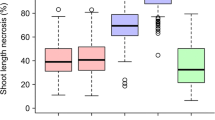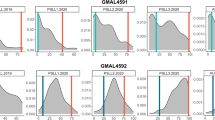Abstract
Fire blight (Erwinia amylovora) causes serious damage to pome fruit orchards, and identification of germplasm with heritable disease resistance is therefore crucial. Two dominant SCAR (sequence characterised amplified region) marker alleles (AE10-375 and GE-8019), flanking a previously identified QTL (quantitative trait locus) for resistance to fire blight on ‘Fiesta’ linkage group 7 in apple cultivars related to ‘Cox’s Orange Pippin’, were screened on 205 apple cultivars. Both marker alleles were present in 22% of the cultivars, indicating presence of the QTL allele for tolerance, and both were lacking in 25%, indicating homozygosity for absence of the QTL tolerance allele. However, 33% had only the marker allele AE10-375, while 20% had only GE-8019, suggesting that some cultivars with the dominant alleles for both of the flanking markers can carry these on separate chromosomes and may lack the QTL allele for tolerance. In 2009 and 2010, terminal shoots of greenhouse-grown grafted trees of 21 cultivars (only 20 in 2010) were inoculated with Erwinia amylovora. ‘Idared’ (susceptible) and ‘Enterprise’ (tolerant) were included as controls. Disease severity for each cultivar was expressed as percentage of necrosis in relation to entire length of shoot, and the ranking of cultivars in 2009 and 2010 was compared with a Spearman rank correlation test, P < 0.01. A relationship between presence of both flanking marker alleles for tolerance and level of fire blight tolerance was confirmed with a Mann–Whitney U-test, P < 0.01 in 2009, and P < 0.05 in 2010. A PCO (principal coordinate) analysis based on band profiles obtained with 12 SSR (simple sequence repeat) loci produced three loose clusters, two of which contained known offspring of ‘Cox’s Orange Pippin’, and one with cultivars that were either unrelated or had an unknown origin. Cases where DNA markers did not predict level of fire blight damage as expected, were, however, as common among descendants of ‘Cox’s Orange Pippin’ as among apparently unrelated cultivars. Obviously the ‘Fiesta’ LG 7 QTL has some predictive value, both for known ‘Cox’ relatives and others, but more efficient markers would be desirable for marker-assisted selection.



Similar content being viewed by others
References
Baumgartner I, Patocchi A, Franck L, Kellerhals M, Broggini G (2011) Fire blight resistance from ‘Evereste’ and Malus sieversii used in breeding for new high quality apple varieties: strategies and results. Acta Hortic 896:391–397
Blazek J (2004) Response to diseases in new apple cultivars from the Czech Republic. J Fruit Ornam Plant Res Special ed. 12:150–241
Bocsanczy AM, Phillips JG, Korban SS, Dardick CD, Bassett CL, Wisniewski ME, Norelli JL (2011) Apple (Malus × domestica) transcriptome in response to the compatible pathogen Erwinia amylovora and the incompatible pathogen Pseudomonas syringae. Acta Hortic 896:237–241
Burokiene D (2010) Survey of Erwinia amylovora in a heavily infested site in northern Lithuania. 12th international workshop on fire blight, Warsaw, 16–20 Aug 2010, p 89
Calenge F, Drouet D, van de Weg WE, Brisset MN, Paulin JP, Durel C-E (2005) Identification of a major QTL together with several minor additive or epistatic QTLs for resistance to fire blight in apple in two related progenies. Theor Appl Genet 111:128–135
Dreo T, Ravnikar M, Frey JE, Smits THM, Duffy B (2011) In silico analysis of variable number of tandem repeats in Erwinia amylovora genome. Acta Hortic 896:115–118
Duffy B, Schärer H-J, Bünter M, Klay A, Holliger E (2005) Regulatory measures against Erwinia amylovora in Switzerland. EPPO Bull 35:239–244
Durel C-E, Denancé C, Brisset M-N (2009) Two distinct major QTL for resistance to fire blight co-localize on linkage group 12 in apple genotypes ‘Evereste’ and Malus floribunda clone 821. Genome 52:139–147
Garkava-Gustavsson L, Kolodinska Brantestam A, Sehic J, Nybom H (2008) Molecular characterisation of indigenous Swedish apple cultivars based on SSR and S-allele analysis. Hereditas 145:99–112
Guarino C, Santoro S, De Simone L, Lain O, Cipriani G, Testolin R (2006) Genetic diversity in a collection of ancient cultivars of apple (Malus × domestica Borkh.) as revealed by SSR-based fingerprinting. J Hort Sci Biotechnol 81:39–44
Hampson CR, Sholberg PL (2008) Estimating combining ability for fire bligth resistance in apple progenies. Acta Hortic 793:337–343
Johnson K, Temple T (2010) Development of non-antibiotic programs for fire blight control in organic apple and pear. 12th international workshop on fire blight, Warsaw, 16–20 Aug 2010 p 69
Keck M, Chartier R, Zislavsky W, Paulin JP (1990) Sensitivity of Erwinia amylovora to high temperatures—possible use of heat treatment for plant propagation material. Acta Hortic 273:259–266
Kellerhals M, Spuhler M, Patocchi A, Frey J (2009) Selection efficiency in apple breeding. Acta Hortic 814:177–183
Keller-Przybylkowicz S, Lewandowski M, Korbin M (2009) Molecular screening of apple (Malus domestica) cultivars and breeding clones for their resistance to fire blight. J Fruit Ornam Plant Res 17(2):31–43
Khan AM, Duffy B, Gessler C, Patocchi A (2006) QTL mapping of fire blight resistance in apple. Mol Breed 17:299–306
Khan AM, Durel C-E, Duffy B, Drouet D, Kellerhals M, Gessler C, Patocchi A (2007) Development of molecular markers linked to the ‘Fiesta’ linkage group 7 major QTL for fire blight resistance and their application for marker-assisted selection. Genome 50:568–577
Korbin M, Keller-Przybylkowicz S, Sobiczewski P, Mikicinski A, Lewandowski M (2010) Molecular scoring for increased fire blight tolerance in apple EU breeding program. 12th international workshop on fire blight, Warsaw, 16–20 Aug 2010, p 61
Lalli D, Norelli J, Malnoy M, Pindo M, Fazio G, Forsline P, Aldwinckle P, Gardiner S, Changné D, Wisniewski M (2010) Determination of fire blight resistance and construction of a molecular genetic map in a bi-parental Malus sieversii population. 12th international workshop on fire blight, Warsaw, 16–20 Aug 2010, p 117
Laurens F, Durel CE, Lascostes M (2004) Molecular characterisation of French local apple cultivars using SSR. Acta Hortic 663:639–641
Le Roux P-MF, Khan MA, Broggini GAL, Duffy B, Gessler C, Patocchi A (2010) Mapping of quantitative trait loci for fire blight resistance in the apple cultivars ‘Florina’ and ‘Nova Easygro’. Genome 53:710–722
Lespinasse Y, Aldwinckle H (2000) Breeding for resistance to fire blight. In: Vanneste JL (ed) Fire blight: the disease and its causative agent, Erwinia amylovora. CAB International, Wallingford, pp 253–273
Liebhard R, Gianfranceschi L, Koller B, Ryder CD, Tarchini R, van de Weg WE, Gessler C (2002) Development and characterisation of 140 new microsatellites in apple (Malus × domestica Borkh.). Mol Breed 10:217–241
Luby JJ, Alspach PA, Bus VGM, Oraguzie NC (2002) Field resistance to fire blight in a diverse apple (Malus sp.) germplasm collection. J Am Soc Hort Sci 127:245–253
Norelli J, Gardiner S, Malnoy M, Aldwinckle H, Baldo A, Bassett C, Fazio G, Horner M, Celton J, Borejsza-Wysocka E, Bowatte D, Charmaine MC, Lalli D, Bus V, Wisniewski M (2010) Candidate fire blight resistance genes in Malus identified with the use of genomic tools and approaches. 12th international workshop on fire blight, 16–20 Aug 2010, Warsaw, p 42
Parravicini G, Broggini G, Denancé C, Laserre P, Vergne-Gaillard E, Brisset M, Durel C, Gessler C (2010) Identification of candidate fire blight resistance genes in apple. 12th international workshop on fire blight, 16–20 Aug 2010, Warsaw, p 43
Peil A, Garcia-Libreros T, Richter K, Trognitz FC, Trognitz B, Hanke M-V, Flachowsky H (2007) Strong evidence for a fire blight resistance gene of Malus robusta located on linkage group 3. Plant Breed 126:470–475
Peil A, Hanke M-V, Flachowsky H, Garcia-Libreros T, Horner M, Bus V, Richter K, Celston J-M, Gardiner S (2008) Confirmation of the fire blight QTL of Malus × robusta 5 on linkage group 3. Acta Hortic 793:297–303
Peil A, Zini E, Richter K, Hanke MV, Malnoy M (2010) Mapping of Malus fusca: a valuable genetic resource for resistance to fire blight. 12th international workshop on fire blight, 16–20 Aug 2010, Warsaw, p 58
Peil A, Flachowsky H, Hanke M-V, Richter K, Rode J (2011) Inoculations of Malus × robusta 5 progeny with a strain breaking resistance to fire blight reveals a minor QTL on LG5. Acta Hortic 896:357–362
Persson P (1995) Väder-päronpest. VäxtEko, 36th Swedish Crop Protection Conference, SLU Info/Växter
Pontais I, Dugé de Bernonville T, Paulin J-P, Brisset M-N (2008) A microarray approach to analyse transciptional changes in apple after infection by Erwinia amylovora. Acta Hortic 793:187–188
Puławska J, Kielak K, Sobiczewski P (2006) Phenotypic and genetic diversity of selected Polish Erwinia amylovora strains. Acta Hortic 704:439–444
Puławska J, Sobiczewski P, Berczynski S, Lewandowski M (2010) Diversity in Erwinia amylovora virulence. 12th international workshop on fire blight, 16–20 Aug 2010, Warsaw, p 31
Rohlf M (2005) NTSYSpc: numerical taxonomy and multivariate analysis system. Version 2.2. State Univ. of New York
Sehic J, Nybom H, Garkava-Gustavsson L, Patocchi A, Kellerhals M, Duffy B (2009) Fire blight (Erwinia amylovora) resistance in apple varieties associated with molecular markers. Int J Hortic Sci 15(1–2):53–57
Smith TJ, Pusey PL (2011) CougarBlight 2010, a significant update of the CougarBlight fire blight infection risk model. Acta Hortic 896:331–336
Smits THM, Rezzonico F, Frey JE, Duffy B, Blom J, Goesmann A (2011) Insights into evolution from comparative genomics of Erwinia amylovora and related species. Acta Hortic 896:259–262
Sobiczewski P, Żurawicz E, Berczyński S, Mikiciński A, Lewandowski M (2008) The importance of the type of Erwinia amylovora inoculum in screening of apple genotypes susceptibility to fire blight. J Fruit Ornam Plant Res 16:305–313
Sobiczewski P, Mikicinski A, Lewandowski M, Zurawicz E, Peil A, Richter K, Kellerhals M (2011) Selection for fire blight resistance of apple genotypes originating from European genetic resources and breeding programs. Acta Hortic 896:399–405
Vanneste JL (2000) What is fire blight? Who is Erwinia amylovora? How to control it? In: Vanneste JL (ed) Fire blight: the disease and its causative agent, Erwinia amylovora. CAB International, Wallingford, pp 1–6
Vantomme R, Rijckaert C, Swings J, de Ley J (1986) Characterisation of further Erwinia amylovora strains and the application of the API 20 system in diagnosis. J Phytopathol 117:34–42
Wojcik D, Michalczuk L, Sobiczewski P, Brzozowska-Michalak J, Mikiciński A, Kowalczys K (2010) Differential gene expression during induction of defence mechanism in apple by selected fire blight control agents. 12th international workshop on fire blight, 16–20 Aug 2010, Warsaw, p 81
Acknowledgments
Material of M. robusta 5 was kindly donated by A. Peil. Financial support was provided by The Swedish Research Council for Environment, Agricultural Sciences and Spatial Planning. This work was conducted within the European Science Foundation funded research network COST Action 864.
Author information
Authors and Affiliations
Corresponding author
Additional information
Communicated by D. Treutter.
A contribution to the Special Issue: Pome Fruit Health
Rights and permissions
About this article
Cite this article
Nybom, H., Mikiciński, A., Garkava-Gustavsson, L. et al. Assessment of fire blight tolerance in apple based on plant inoculations with Erwinia amylovora and DNA markers. Trees 26, 199–213 (2012). https://doi.org/10.1007/s00468-011-0649-4
Received:
Revised:
Accepted:
Published:
Issue Date:
DOI: https://doi.org/10.1007/s00468-011-0649-4




